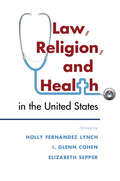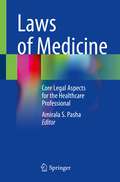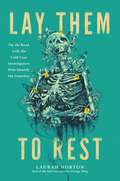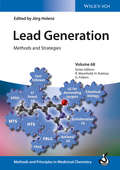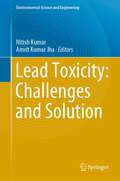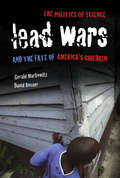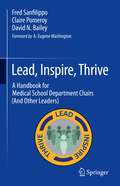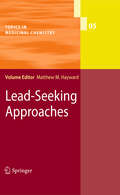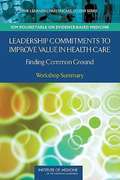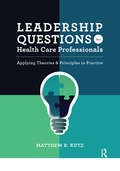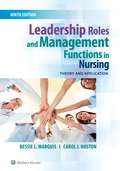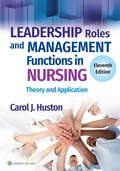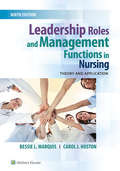- Table View
- List View
Law, Religion, and Health in the United States
by Cohen Lynch Holly Fernandez I. Glenn Elizabeth SepperWhile the law can create conflict between religion and health, it can also facilitate religious accommodation and protection of conscience. Finding this balance is critical to addressing the most pressing questions at the intersection of law, religion, and health in the United States: should physicians be required to disclose their religious beliefs to patients? How should we think about institutional conscience in the health care setting? How should health care providers deal with families with religious objections to withdrawing treatment? In this timely book, experts from a variety of perspectives and disciplines offer insight on these and other pressing questions, describing what the public discourse gets right and wrong, how policymakers might respond, and what potential conflicts may arise in the future. It should be read by academics, policymakers, and anyone else - patient or physician, secular or devout - interested in how US law interacts with health care and religion.
Law-and-Order News: An analysis of crime reporting in the British press (International Behavioural And Social Sciences Ser. #Vol. 17)
by Steve ChibnallTavistock Press was established as a co-operative venture between the Tavistock Institute and Routledge & Kegan Paul (RKP) in the 1950s to produce a series of major contributions across the social sciences. This volume is part of a 2001 reissue of a selection of those important works which have since gone out of print, or are difficult to locate. Published by Routledge, 112 volumes in total are being brought together under the name The International Behavioural and Social Sciences Library: Classics from the Tavistock Press. Reproduced here in facsimile, this volume was originally published in 1977 and is available individually. The collection is also available in a number of themed mini-sets of between 5 and 13 volumes, or as a complete collection.
Laws of Medicine: Core Legal Aspects for the Healthcare Professional
by Amirala S. PashaThis book provides an overview of the US laws that affect clinical practice for healthcare professionals with no legal background.Divided into thirteen sections, each chapter starts with a summary of the chapter’s content and relevant legal concepts in bullet points before discussing the topics in detail. An application section is provided in many chapters to clarify essential issues by reflecting on clinically relevant case law or clinical vignette(s). Filling a crucial gap in the literature, this comprehensive guide gives healthcare professionals an understanding or a starting point to legal aspects of healthcare.
Lawyered To Death: a Karen Hayes mystery
by Michael BiehlThe successful CEO of a Midwest hospital, begins an affair with a hospital receptionist, unaware that she and her husband, are setting him up for an embarrassing and costly sexual harassment claim
Lay Them to Rest: On the Road with the Cold Case Investigators Who Identify the Nameless
by Laurah NortonTake a fascinating deep dive into the dark world of forensic science as experts team up to solve the identity of an unknown woman by exploring the rapidly evolving techniques being used to break the most notorious cold cases. Fans of true crime shows like CSI, NCIS, Criminal Minds, and Law and Order know that when it comes to &“getting the bad guy&” behind bars, your best chance of success boils down to the strength of your evidence—and the forensic science used to obtain it. Beyond the silver screen, forensic science has been used for decades to help solve even the most tough-to-crack cases. In 2018, the accused Golden State Killer, Joseph DeAngelo, was finally apprehended after a decades-long investigation thanks to a very recent technique called forensic genealogy, which has since led to the closure of hundreds of cold cases, bringing long-awaited justice to victims and families alike. But when it comes to solving these incredibly difficult cases, forensic genealogy is just the tip of the iceberg—and many readers have no idea just how far down that iceberg goes. For Laurah Norton, forensic science was always more of a passion than anything else. But after learning about a mishandled 1990s cold case involving missing twins, she was spurred to action, eventually creating a massively popular podcast and building a platform that helped bring widespread attention and resources to the case. LAY THEM TO REST builds on Laurah&’s fascination with these investigations, introducing readers to the history and evolution of forensic science, from the death masks used in Ancient Rome to the 3-D facial reconstruction technology used today. Incorporating the stories of real-life John & Jane Does from around the world, Laurah also examines how changing identification methods have helped solve the most iconic cold cases. Along the way readers will also get to see Laurah solve a case in real time with forensic anthropologist Dr. Amy Michael, as they try to determine the identity of &“Ina&” Jane Doe, a woman whose head was found in a brush in an Illinois park in 1993. More than just a chronicle of the history of forensics, LAY THEM TO REST is also a celebration of the growing field of experts, forensic artists, and anthropologists (many of whom Laurah talks to in the book), who work tirelessly to bring closure to these unsolved cases. And of course, this book asks why some cases go unsolved, highlighting the &“missing missing,&” the sex workers, undocumented, the cases that so desperately need our attention, but so rarely get it. Engrossing, informative, heartbreaking, and hopeful, LAY THEM TO REST is a deep dive into the world of forensic science, showing readers how far we&’ve come in cracking cases and catching killers, and illuminating just how far we have yet to go.
Lazaretto: How Philadelphia Used an Unpopular Quarantine Based on Disputed Science to Accommodate Immigrants and Prevent Epidemics
by David S. BarnesHow the controversial practice of quarantine saved nineteenth-century Philadelphia after a series of deadly epidemics.In the 1790s, four devastating yellow fever epidemics threatened the survival of Philadelphia, the nation's capital and largest city. In response, the city built a new quarantine station called the Lazaretto downriver from its port. From 1801 to 1895, a strict quarantine was enforced there to protect the city against yellow fever, cholera, typhus, and other diseases. At the time, the science behind quarantine was hotly contested, and the Board of Health in Philadelphia was plagued by internal conflicts and political resistance. In Lazaretto, David Barnes tells the story of how a blend of pragmatism, improvisation, and humane care succeeded in treating seemingly incurable diseases and preventing further outbreaks.Barnes shares the lessons of the Lazaretto through a series of tragic and inspiring true stories of people caught up in the painful ordeal of quarantine. They include a nine-year-old girl enslaved in West Africa and freed upon arrival in Philadelphia, an eleven-year-old orphan boy who survived yellow fever only to be scapegoated for starting an epidemic, and a grieving widow who saved the Lazaretto in the midst of catastrophe. Spanning a turbulent century of immigration, urban growth, and social transformation, Lazaretto takes readers inside the life-and-death debates and ordinary heroism that saved Philadelphia when its survival as a city was at stake. Amid the controversy and tragedy of the COVID-19 pandemic, this surprising reappraisal of America's historic struggle against deadly epidemics reminds us not to neglect old knowledge and skills in our rush to embrace the new.
Lazarus Rising: A Novel
by Joseph CaldwellThe Rome Prize–winning author of In the Shadow of the Bridge&“evokes a bygone era and an earlier pandemic. . . . An affecting turn in [his] long career&” (Publishers Weekly). This dark, propulsive novel, the crowning masterwork by ninety-two-year-old Joseph Caldwell, takes place during 1992, when AIDS was still an incurable scourge and death casualties were everyday events. One cold winter night, when the artist Dempsey Coates is on her way home to her loft, she encounters a blaze, several alarms ringing and water jetting every which way from fire hydrants. She ends up offering several firemen a place to get warm. One of them is Johnny Donegan, a passionate lad who falls madly in love with her and is determined, through prayer and sheer perseverance, to make a life with Dempsey unimpeded by the specter of her illness. But when the couple is finally blessed with an unexpected stroke of good luck, this one twist of fate that promises an enduring future will end up coming between them in a very tragic and unforeseen way. Praise for In the Shadow of the Bridge &“A moving memoir and a look at gay and artistic life in New York City from the 1950s on, through the AIDS epidemic.&” —New York Post &“In telling the story of coming to NYC as a young man, grappling with his desire to be an artist, to be a man of faith, and his desire for the love of another man, Joseph Caldwell tells the story of a time and place—the story of a generation.&” —A. M. Homes, Orange Prize–winning author of May We Be Forgiven
Lazy, Crazy, and Disgusting: Stigma and the Undoing of Global Health
by Alexandra Brewis Amber WutichDrawing on the authors' keen observations and decades of fieldwork, Lazy, Crazy, and Disgusting combines a wide array of ethnographic evidence from around the globe to demonstrate conclusively how stigma undermines global health's basic goals to create both health and justice.
Lazy, Crazy, and Disgusting: Stigma and the Undoing of Global Health
by Alexandra Brewis Amber WutichPromotional headline: How stigma derails well-intentioned public health efforts, creating suffering and worsening inequalities.2020 Winner, Society for Anthropological Sciences Carol R. Ember Book PrizeShortlisted for the British Sociological Association's Foundation for the Sociology of Health and Illness Book PrizeStigma is a dehumanizing process, where shaming and blaming are embedded in our beliefs about who does and does not have value within society. In Lazy, Crazy, and Disgusting, medical anthropologists Alexandra Brewis and Amber Wutich explore a darker side of public health: that well-intentioned public health campaigns can create new and damaging stigma, even when they are otherwise successful. Brewis and Wutich present a novel, synthetic argument about how stigmas act as a massive driver of global disease and suffering, killing or sickening billions every year. They focus on three of the most complex, difficult-to-fix global health efforts: bringing sanitation to all, treating mental illness, and preventing obesity. They explain how and why humans so readily stigmatize, how this derails ongoing public health efforts, and why this process invariably hurts people who are already at risk. They also explore how new stigmas enter global health so easily and consider why destigmatization is so very difficult. Finally, the book offers potential solutions that may be able to prevent, challenge, and fix stigma. Stigma elimination, Brewis and Wutich conclude, must be recognized as a necessary and core component of all global health efforts.Drawing on the authors' keen observations and decades of fieldwork, Lazy, Crazy, and Disgusting combines a wide array of ethnographic evidence from around the globe to demonstrate conclusively how stigma undermines global health's basic goals to create both health and justice.
Le Bégaiement: Sa Nature et une Approche Pratique pour le Traitement
by A. N. OkonobohPeut-on arrêter de bégayer en 10 jours ? Quel est votre plus grand rêve dans la vie ? En tant que bègue, vous ne voulez pas qu'on compatisse quand vous parlez. Dans notre livre, LE BEGAIEMENT, c'est à vous que nous pensons. Dans les groupes de paroles, on dit souvent aux bègues de ne plus s'embêter avec la guérison, qu'un tel effort est plus dévastateur que le défaut d'élocution lui-même. Cette introduction veut vous inspirer et vous aider à dissiper vos craintes. Nous allons maintenant vous donner l'idée générale des particularités du livre qui contribue à accélérer la guérison du bégaiement. Tout d'abord, ce livre est basé sur des années d'études de vraies personnes qui ont vaincu le bégaiement, pas sur une théorie intellectuelle de laboratoire. C'est pour cela qu'il marche. L'élément central est la PRISE DE CONSCIENCE, qui constitue le fil conducteur des différents chapitres. Autour de celle-ci nous ajoutons d'autres éléments qui, par leurs rôles positifs ou négatifs, méritent d'être soulignés. Par ex. : le contrôle de la respiration, l'art de la parole, la gestion des obstacles courants, l'utilisation des schémas de parole, etc. Dans « L'art de la parole », nous traitons de tous les problèmes d'orthophonie, la thérapie comportementale et cognitive, le soulagement de l'anxiété, l'autoguérison du bégaiement ainsi que l'aide que quelqu'un peut apporter pour trouver sa voix. La même section poursuit son efficacité dans le défi de l'enseignement de la parole, la thérapie pour les enfants, même dans les cas les plus sévères. Enfin, nous alertons les parents ou gardiens pour qu'ils soient attentifs à tout indice de bégaiement dans la petite enfance. Nos conseils pratiques sont très faciles à suivre. Nous avons développé ces stratégies et activités pour promouvoir le développement du langage de votre enfant. Ce sont des compétences sociales détaillées afin d'aider les jeunes enfants et les adultes à a
Le Eruzioni del Permafrost
by Louis P. KichaAlcuni virus e dei batteri hanno trascorso 30 mila anni in letargo nel permafrost profondo. Liberati dal cambiamento climatico, ora stanno causando malattie e morte ad una popolazione vulnerabile. Ci vorranno tutte le conoscenze, le abilità e le competenze di cui i dottori Raymond Salazar e Peter Fleming saranno capaci per comprendere e sconfiggere gli organismi mortali prima che il pianeta venga devastato!
Le mal d'Alzheimer III
by Juan Moisés de la SernaComment traite-t-on la maladie d’Alzheimer ? Quelle est son évolution ? Comment peut-on prévenir son évolution ? Apprenez au sujet des dernières avancées en termes de prévention et de traitement de la maladie d’Alzheimer. Un des aspects les plus importants d’une maladie est de savoir comment la vaincre, si elle dispose d’un remède et quel est le traitement. A ce sujet, de nombreux progrès sont réalisés en permanence dans le domaine de la recherche de traitement et de prévention de la maladie d’Alzheimer, comme nous les présenterons dans cet écrit. Objectif : L’objectif du livre est de servir de première approche à toute personne touchée de près ou de loin par la maladie d’Alzheimer, qu’elle soit elle-même la personne malade ou qu’il s’agisse d’un proche. Ce livre cherche à présenter de façon claire les résultats des dernières recherches sur la maladie d’Alzheimer, dans le but de répondre aux questions les plus pertinentes : comment se traite cette maladie ? quelle est son évolution ? comment se prévient-elle ? Destinataires : Professionnels de santé qui doivent approfondir leurs connaissances en termes de diagnostic et de traitement de la maladie d’Alzheimer. Professeurs qui souhaitent fournir une information actualisée à leurs élèves sur la maladie d’Alzheimer. Tous ceux qui ont été diagnostiqués de la maladie d’Alzheimer et leurs proches afin de savoir que faire face à cette maladie Thématique Ci-dessous, voici le détail de chacune des thématiques principales de cette ouvrage : Traitement de l’Alzheimer : malgré les limites des traitements actuels, de nouvelles découvertes sont réalisées chaque jour afin de faire face à cette maladie Évolution de l’Alzheimer : la maladie d’Alzheimer se définit comme une maladie progressive, c’est-à-dire qu’avec le temps, elle provoque la perte des capacités co
Lead Generation: Methods and Strategies, Volume 67
by Raimund Mannhold Gerd Folkers Hugo Kubinyi Jörg HolenzIn this comprehensive two-volume resource on the topic senior lead generation medicinal chemists present a coherent view of the current methods and strategies in industrial and academic lead generation. This is the first book to combine both standard and innovative approaches in comparable breadth and depth, including several recent successful lead generation case studies published here for the first time. Beginning with a general discussion of the underlying principles and strategies, individual lead generation approaches are described in detail, highlighting their strengths and weaknesses, along with all relevant bordering disciplines like e. g. target identification and validation, predictive methods, molecular recognition or lead quality matrices. Novel lead generation approaches for challenging targets like DNA-encoded library screening or chemical biology approaches are treated here side by side with established methods as high throughput and affinity screening, knowledge- or fragment-based lead generation, and collaborative approaches. Within the entire book, a very strong focus is given to highlight the application of the presented methods, so that the reader will be able to learn from `real life? examples. The final part of the book presents several lead generation case studies taken from different therapeutic fields, including diabetes, cardiovascular and respiratory diseases, neuroscience, infection and tropical diseases. The result is a prime knowledge resource for medicinal chemists and for every scientist involved in lead generation.
Lead Toxicity: Challenges and Solution (Environmental Science and Engineering)
by Nitish Kumar Amrit Kumar JhaThis book delivers an outline to graduate, undergraduate students, and researchers, as well as academicians who are working on lead toxicity with respect to remediation. It covers sources of lead contamination and its impact on human health and on prospective remediation through multi-disciplinary approaches with application of recent advanced biological technology. Lead is among the elements that have been most extensively used by man over time. This has led to extensive pollution of surface soils on the local scale, mainly associated with mining and smelting of the metal and addition of organic lead compounds to petrol. Release of lead to the atmosphere from various high-temperature processes has led to surface contamination on the regional and even global scale. In addition, plants grown on lead-rich soils incorporate lead, and thus, the concentration of lead in crop plants may be increased. Lead enters in the food chain through consumption of plant material. A high concentration of lead has been found to be harmful to vegetation. As the lead concentration increases, it adversely affects several biological parameters and eventually renders the soil barren. This edited book brings together a diverse group of researchers to address the challenges posed by global mass poisoning caused by lead contamination of soil and plants. The book sheds light on this global environmental issue and proposes solutions to contamination through multi-disciplinary approaches. This book contains three sections. The first section describes the different sources and distribution of lead in soil and plant ecosystems. The second section explains the health risks linked to lead toxicity. The third section addresses sustainable lead toxicity mitigation strategies and the potential applications of recent biological technology in providing solutions. This book is a valuable resource to students, academics, researchers, and environmental professionals doing fieldwork on lead contamination throughout the world.
Lead Wars
by David Rosner Gerald MarkowitzIn this incisive examination of lead poisoning during the past half century, Gerald Markowitz and David Rosner focus on one of the most contentious and bitter battles in the history of public health. Lead Wars details how the nature of the epidemic has changed and highlights the dilemmas public health agencies face today in terms of prevention strategies and chronic illness linked to low levels of toxic exposure. The authors use the opinion by Maryland's Court of Appeals--which considered whether researchers at Johns Hopkins University's prestigious Kennedy Krieger Institute (KKI) engaged in unethical research on 108 African-American children--as a springboard to ask fundamental questions about the practice and future of public health. Lead Wars chronicles the obstacles faced by public health workers in the conservative, pro-business, anti-regulatory climate that took off in the Reagan years and that stymied efforts to eliminate lead from the environments and the bodies of American children.
Lead, Inspire, Thrive: A Handbook for Medical School Department Chairs (And Other Leaders)
by Claire Pomeroy Fred Sanfilippo David N. BaileyThis handy reference will help medical school department chairs and other Academic Health Center (AHC) leaders navigate the important, challenging and complex responsibilities and opportunities of their positions, whether they are new, experienced or future leaders. Medical school department chairs support four distinct missions (education, research, clinical care and public service), which serve multiple constituents, have different measures of success, and sometimes are in direct conflict for resources across the different priorities of their AHC and its component organizations. Having served as medical school department chairs, program and center directors, medical school deans, and AHC chief executives, the authors have seen first-hand the increasing difficulty and complexity of these roles and the inspiring impact these leaders can have on those they serve. This book shares their insights by providing contemporary and comprehensive information to help these leaders navigate the many issues and opportunities they face. While serving as a medical school department chair is challenging on many levels, it is one of the most important roles in AHCs and can be an extremely rewarding leadership position. Timely advice and guidance are keys to success, and this book articulates and answers the most common questions faced by medical school department chairs and other leaders over their careers.
Lead-Seeking Approaches
by Matthew M. HaywardChristopher A. Lipinski: Overview of hit to lead: the medicinal chemistâ__s role from HTS retest to lead optimization hand offJeff W. Paslay â_¢ John E. Morin â_¢ Richard K. Harrison: High Throughput Screening in the 21st CenturyJack Andrew Bikker â_¢ Lakshmi S. Narasimhan: Lead Discovery Using Virtual Screening Maurizio Pellecchia: NMR Spectroscopy in Fragment Based Drug DesignKevin D. Freeman-Cook â_¢ Daniel W. Kung: Hit Triage â__ Medicinal Chemistry Strategies to Improve the Odds of Success in DiscoveryJohn W. Ellingboe â_¢ Adam M. Gilbert: Lead Identification
Leadership Commitments to Improve Value in Health Care: Finding Common Ground
by Institute of MedicineThis volume reports on discussions among multiple stakeholders about ways they might help transform health care in the United States. The U.S. healthcare system consists of a complex network of decentralized and loosely associated organizations
Leadership Development for Interprofessional Education and Collaborative Practice
by Marion Jones Jill Thistlethwaite Dawn FormanLeadership Development of Interprofessional Education and Collaborative Practice is an edited compilation of chapters written by international medical and health professional experts. The book provides historical and current perspectives on leadership in healthcare.
Leadership Pearls in Healthcare
by Ralph Junckerstorff Sara BaqarThis book brings together the insights of some of Australia&’s most respected healthcare professionals and provides a resource for readers new to the concept of leadership and those currently in leadership or managerial positions. Administrative (as opposed to clinical) leadership and the skills required to be good at it, are not well covered in the medical, nursing or allied health curricula. Despite this, healthcare workers are often required to take up leadership/managerial roles, often with little notice and minimal training. In contrast to the scientific nature of clinical medicine, leadership is a management concept and open to different interpretations. Clinicians who have the potential to be great leaders may shy away from administrative leadership positions because of limited understanding and training in what leadership entails. Unfortunately, not all great clinicians turn out to be great leaders/managers. Leadership Pearls in Healthcare delves deep into the minds of eminent leaders across all disciplines within the Australian healthcare system and discover the most valuable lessons they have learnt during their leadership journey. To demonstrate how they can be applied in practice, each leadership pearl will be presented in a scenario/situation-based format, followed by a discussion with relevant references. Following this, authors will include closely related practical tips as &‘Other Gems&’. Designed in an engaging and user-friendly format, this book is accessible to a wide audience, including current and emerging leaders in healthcare, students in medical, nursing, allied health, recently graduated doctors, nurses, and allied health professionals, as well as current and emerging leaders outside of healthcare.
Leadership Questions for Health Care Professionals: Applying Theories and Principles to Practice
by Matthew KutzLeadership Questions for Health Care Professionals: Applying Theories and Principles to Practice by Dr. Matthew R. Kutz presents some of the most common leadership questions with the intent to facilitate intrigue and dialogue about the general concept of leadership and an awareness of potential leadership issues facing health care professionals.Leadership Questions for Health Care Professionals presents responses that will initiate discussion, as well as offer solutions based on the best available evidence across a wide spectrum of relevant research. Discussion questions at the end of each response will allow the reader to engage in critical thinking and re-evaluate their experiences and offer new insights into their leadership journey.Sections include questions on key issues for health care professionals: The essence of leadership Leadership development Teamwork and communication Change Organizational culture and complexity Leadership ethics and power Diversity and multicultural leadership Leadership Questions for Health Care Professionals takes an interprofessional and interdisciplinary approach and is relevant for athletic trainers, physical therapists, occupational therapists, speech-language pathologists, nurses, physicians, and more.Leadership Questions for Health Care Professionals: Applying Theories and Principles to Practice offers students a broader conceptual understanding of leadership, as well as the depth required by seasoned health care clinicians, managers, and executives who are looking for practical and evidence-based insights to their toughest leadership issues.
Leadership Roles Management Functions In Nursing: Theory And Application
by Carol Huston Marquis L.Now in its Fifth Edition, this foremost leadership and management text incorporates application with theory and emphasizes critical thinking, problem solving, and decision making. <P><P>More than 225 case studies and learning exercises promote critical thinking and interactive discussion. This edition includes 46 new case studies in settings such as acute care, ambulatory care, long-term care, and community health. <P><P>The book addresses timely nursing leadership and management issues, such as leadership development, staffing, delegation, ethics and law, organizational, political, and personal power, management and technology, and more. <P><P>Web links and learning exercises appear in each chapter. An Instructor's CD-ROM includes a testbank and PowerPoint slides.
Leadership Roles and Management Functions in Nursing: Theory and Application
by Carol J. HustonCombining an equal focus on leadership and management with a proven experiential approach, Leadership Roles and Management Functions in Nursing: Theory and Application, 11th Edition, delivers the knowledge, understanding, and realistic leadership experience today’s students need to confidently transition to nursing practice. This best-selling text clarifies theoretical content with a wealth of application-based learning exercises that put students into nursing leadership roles and challenge them to think critically, solve problems, and make sound clinical decisions before embarking on their nursing careers. The updated 11th Edition reflects the latest evidence-based content and incorporates engaging online resources that help students establish a foundation for successful nursing practice in any role or clinical setting.
Leadership Roles and Management Functions in Nursing: Theory and Application (Coursepoint For Bsn Ser.)
by Carol J. Huston Bessie L. MarquisHelp your students develop the skills they’ll need on the job with today’s #1 bestseller. Taking an active learning approach, this Ninth Edition emphasizes the symbiotic elements of leadership and management. All professional nurses today face limited resources and emerging technologies, and this book prepares students through up-to-date and comprehensive coverage of leadership and management concepts, ranging from managing conflict and working collaboratively to organizing patient care and staffing. Benefitting students who often have limited opportunities to observe high-performing middle- and top-level managers in practice, a variety of real-world scenarios are featured throughout and provide opportunities for hands-on learning. New to the Ninth Edition: More than 280 learning exercises (26 NEW to this edition) help students see how concepts can be applied in a wide range of practice situations and health-care settings. The variety of learning modes in the exercises gives students opportunities to apply theory, develop strong critical-thinking skills, and internalize learning. Updated Content Crosswalks—based on the latest AACN, AONE, QSEN, and, new to this edition, ANA standards and competencies—show how content in each chapter draws from or contributes to content identified as essential for baccalaureate and graduate education, for practice as a nurse administrator, and for safety and quality in clinical practice. Updated content on new trends/developments in health care includes the Affordable Care Act, meaningful EHR use, projected nursing shortages, and newer care delivery models focused on ambulatory care and outpatient settings. Expanded coverage of workplace topics includes whistleblowing, liability of supervision of unlicensed workers, bullying, incivility, mobbing, workplace violence, and the authority-power gap. Improved leveling in the test bank allows for better assessment of student progress.
Leadership Skills for Dental Professionals: Begin Well to Finish Well
by Mark Keane Andrew Munro Raman BediLeadership Skills for Dental Professionals Equips all members of the dental team with the key leadership skills for professional and personal life Leadership Skills for Dental Practitioners: Begin Well to Finish Well is an authoritative guide to better leadership in dentistry. Designed to prepare every member of the dental team for the leadership tasks and challenges they will face in general practice, this comprehensive resource helps the reader to develop skills not explicitly taught in traditional dental education. The book’s content has arisen from the Senior Dental Leadership programme which is a public private partnership between the Global Child Dental Fund charity, King’s College London, Harvard School of Dental Medicine, Henry Schein and Colgate Palmolive. Throughout the book, practical advice is provided on fourteen capabilities for a balanced and credible leadership approach to application within a clinical context. Topics include: how to influence to have impact teamwork and collaboration credibility: how to gain it and lose it values for leadership practice and business ethics dealing with difficult people and managing conflict body language: fiction and facts Leadership Skills for Dental Practitioners: Begin Well to Finish Well is a much-needed guide for every member of the dental team.
